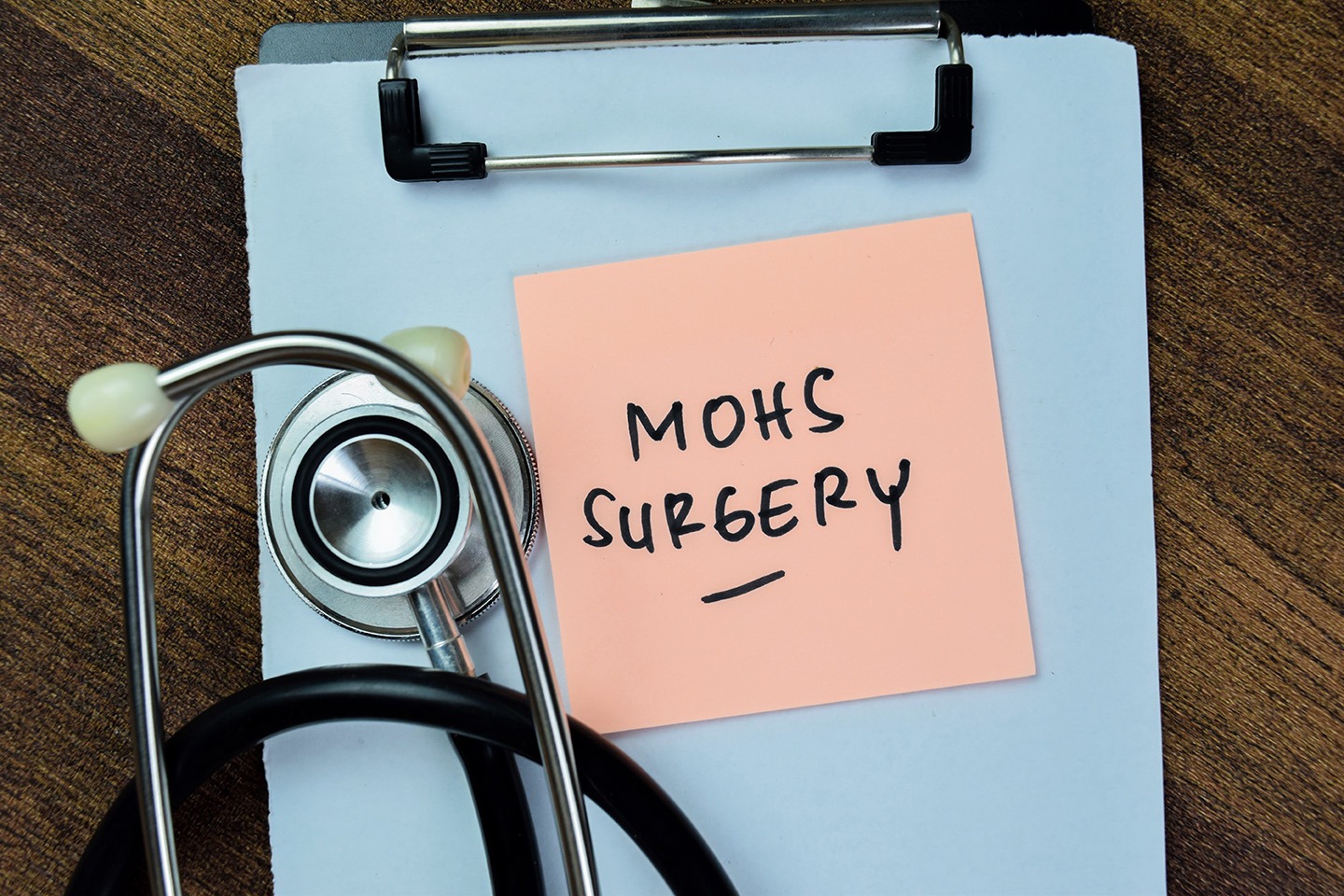Mohs Surgery Explained: Why It’s the Gold Standard for Skin Cancer Removal

When it comes to treating skin cancer, precision and peace of mind matter most. Mohs surgery offers the highest cure rates while preserving as much healthy tissue as possible, making it a preferred option for many dermatologists and patients. This advanced procedure is designed to confirm that all cancer cells are removed during your visit—often in a single appointment.
What Is Mohs Surgery?
Mohs surgery is a specialized surgical technique for removing certain skin cancers layer by layer while examining each section under a microscope until no cancer cells remain.
Developed by Dr. Frederic Mohs in the 1930s, this approach combines precise surgery with immediate microscopic analysis. Unlike standard excisions, where tissue is sent to an offsite lab, Mohs surgery allows for same-day confirmation that cancer has been addressed.
According to The Skin Cancer Foundation, Mohs surgery is considered one of the most effective techniques for treating certain types of skin cancers, especially in areas where preserving healthy tissue is critical.
Fun fact: Many patients ask, what does Mohs surgery stand for? It’s actually not an acronym. It’s simply named after its creator, Dr. Frederic Mohs!
How Mohs Surgery Works
Mohs surgery is a systematic process that prioritizes accuracy and tissue preservation. It involves multiple stages, all completed in a single visit under local anesthesia.
Step-by-Step Process
Mohs surgery is performed in stages under local anesthesia, so you remain awake and comfortable throughout the procedure. Here’s how it works:
- Local anesthesia is administered to completely numb the area.
- The visible tumor is carefully removed.
- A thin layer of surrounding tissue is taken and mapped for analysis.
- The tissue is examined immediately to check for remaining cancer cells.
- Additional layers are removed only where cancer is detected.
This continues until no cancer cells are seen under the microscope, which often requires multiple stages in a single visit.
Same-Day Lab Review
One notable advantage of Mohs surgery is that tissue analysis takes place onsite during the procedure. Your Mohs surgeon, often fellowship-trained, acts as both surgeon and pathologist. This real-time review allows the surgeon to verify that cancer has been fully addressed before the wound is closed, significantly reducing the risk of recurrence.
Why Mohs Is the Gold Standard
Mohs surgery is widely recognized as the most effective treatment for many nonmelanoma skin cancers. Here’s why it’s considered the gold standard:
Highest Cure Rates
Mohs surgery offers the highest cure rates for basal cell and squamous cell carcinomas. Studies show cure rates of up to 99% for primary basal cell carcinoma and approximately 94% or higher for recurrent tumors. This makes it the preferred option when complete cancer removal is critical.
Tissue-Sparing Technique
Unlike traditional excision, Mohs removes only the tissue affected by cancer while leaving surrounding healthy skin intact. This precision is especially important for areas like the face, eyelids, lips, and hands, where both function and appearance matter. The technique reduces unnecessary scarring and supports better cosmetic results.
Immediate Results
With Mohs, there is no waiting for an off-site pathology report. Each tissue layer is analyzed in real time during the procedure. This approach allows your dermatologist to address any remaining cancer immediately, so you leave the office confident that the cancer has been treated.
Reduces Risk of Recurrence
Mohs surgery examines 100% of the surgical margin under a microscope, which significantly lowers the chance of cancer returning. This level of thoroughness is unmatched by most other skin cancer treatments, making it ideal for aggressive or previously treated tumors.
Who Is a Good Candidate for Mohs Surgery?
Mohs surgery isn’t necessary for every type of skin cancer, but it’s recommended in cases where precision and tissue preservation are especially important. Dermatologists often choose Mohs for cancers in sensitive or high-risk areas, as well as for tumors that are large, aggressive, or have returned after previous treatment.
Mohs surgery is often recommended for:
- Basal cell or squamous cell carcinoma
- Tumors in high-risk or cosmetically sensitive areas (face, eyelids, lips, ears, hands)
- Recurrent or large tumors
- Tumors with poorly defined borders or aggressive growth patterns
Your dermatologist will review your diagnosis and determine if Mohs is appropriate for your case.
What to Expect Before, During, and After Mohs Surgery
Knowing what to expect can help reduce anxiety and make your Mohs surgical experience smoother. Here’s what you can expect from each stage of the process:
Before the Procedure
Before your appointment, your dermatologist will review your medical history, current medications, and any health conditions that might affect healing. You’ll receive instructions on which medications to continue, which to stop (such as blood thinners if advised), and whether you should eat or drink before your procedure. Most patients can maintain normal activities the day before, but plan to take it easy on the day of surgery, as the process can take several hours.
During the Procedure
Mohs surgery is performed under local anesthesia, so you’ll be awake but completely numb in the treatment area. This approach avoids the risks of general anesthesia and allows patients to remain comfortable throughout the procedure. Because tissue layers are removed and examined one at a time, the entire process can take a few hours.
How long does Mohs surgery take? Most patients should expect to spend half a day at the office, as the surgeon carefully checks each layer under a microscope before proceeding.
Aftercare & Recovery
After your procedure, your care team will give you detailed instructions for wound care, including how to keep the area clean and covered. Most patients are advised to apply a thin layer of Vaseline for about one to two weeks or until the wound fully heals. Bandages are usually kept in place for the first 24 to 48 hours, then changed according to your dermatologist’s recommendations.
During recovery, monitor the site for signs of infection after Mohs surgery, such as increased redness, swelling, warmth, drainage, or pain, and contact your doctor promptly if any of these occur.
Mohs Surgery vs. Other Skin Cancer Treatments
There are several options for treating skin cancer, and understanding the differences can help you make an informed decision. While methods like excisional surgery, cryotherapy, topical treatments, and radiation are commonly used, Mohs surgery stands apart for its precision and success rates. Here’s how Mohs compares to other treatments:
| Treatment | Cure Rate | Tissue Preservation | Same-Day Results |
| Mohs Surgery | Highest (up to 99%) | Yes | Yes |
| Excisional Surgery | Moderate | Less precise | No |
| Cryotherapy | Lower | Not precise | Yes |
| Topical Therapies | Lower | Yes | No |
| Radiation | Moderate | Yes | No |
Trust Your Skin to Experienced Mohs Dermatologists
Mohs surgery requires advanced skill and precision that go beyond standard dermatologic care. At Clarus Dermatology, our physicians are board-certified dermatologists with extensive training and experience in Mohs micrographic surgery.
This depth of expertise helps provide top-tier care focused on complete cancer removal while preserving as much healthy tissue as possible. By combining accuracy with careful attention to cosmetic and functional outcomes, our team is committed to delivering the best possible results for every patient.
Schedule a Mohs Surgery Consultation Today
Have you been referred for Mohs surgery? Concerned about a persistent spot or lesion? Don’t wait—early treatment is key to preventing complications and preserving healthy tissue.
Our team will take the time to review your diagnosis, answer your questions, and create a treatment plan tailored to your needs. Whether you’re seeking peace of mind or next steps after a biopsy, we’re here to help you move forward with confidence.
Frequently Asked Questions
What is a Mohs procedure?
A Mohs procedure is a specialized surgical technique for removing certain skin cancers with the highest precision. It involves removing thin layers of tissue one at a time, examining each layer under a microscope, and continuing until no cancer cells remain. This method helps ensure maximum cancer clearance while preserving healthy skin.
How long to use Vaseline after Mohs surgery?
At Clarus Dermatology, we typically recommend applying a thin layer of Vaseline for one to two weeks, or until the wound fully heals. Keeping the area moist helps promote faster healing and minimize scarring. Your care team will give you personalized aftercare instructions during your visit.
How long do I wear a bandage after Mohs surgery?
Most patients keep the initial bandage on for 24 to 48 hours. After that, we’ll guide you on when and how to change dressings as your wound heals. Every case is unique, so we provide specific recommendations during your aftercare appointment to ensure proper healing and comfort.
How much does Mohs surgery cost?
Costs for Mohs surgery vary depending on the size and complexity of the cancer and whether reconstruction is needed. Most insurance plans, including Medicare, cover this procedure because it is medically necessary. Our team will help you confirm coverage and review any out-of-pocket costs before treatment.


